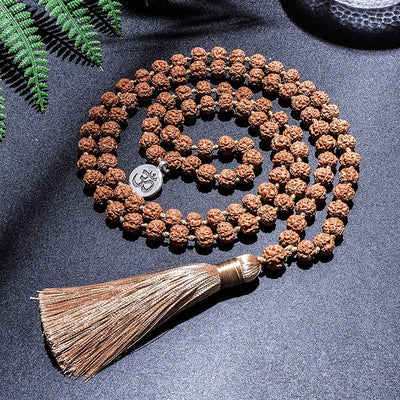POWERFUL LIST OF MALA MANTRAS FOR EVERY INTENTION
What Are Mala Mantras?
Mala mantras are repetitive chants or prayers that are recited while using a mala, which is a string of beads used for counting. These mantras for meditation hold great significance in various spiritual practices and are believed to have the power to unlock and channel energy and they play a vital role in focusing the mind and connecting with the divine. Mala mantras are found in different cultures and traditions worldwide, transcending religious boundaries. They offer a range of benefits, including relaxation, stress relief, enhanced focus, mindfulness, and the cultivation of positive qualities. Choosing a mala mantra is a personal process that involves resonance, intention, and finding inner peace and joy.
13 Popular Mala Mantras for Different Intentions
In this section, we will explore some popular Sanskrit mantras that are commonly used for different intentions in spiritual practices. Mala mantras are believed to have the power to manifest desired outcomes and bring about positive changes in one's life. Whether you are seeking peace, love, abundance, or spiritual growth, there is a mala mantra suitable for your intention.
Check out our rudraksha mala beads here

1. Om:
Often referred to as the universal sound, "Om" is one of the most important and powerful mantras. It represents the sound of the universe and the ultimate reality in Hinduism.
2. Om Namah Shivaya:
This is one of the most popular Hindu mantras, dedicated to Lord Shiva. It's often translated as "I bow to Shiva," with Shiva being the supreme reality Is believed to bring about deep inner transformation. It is chanted to invoke the qualities of peace, harmony, and spiritual awakening. By reciting this mantra, one can connect with their inner self and attain spiritual liberation.
3. Om Mani Padme Hum:
This is a very important mantra in Buddhism, especially in Tibetan Buddhism. It's the mantra of the bodhisattva of compassion, Avalokiteshvara. It's often translated as "the jewel in the lotus. Bodhisattva Avalokiteshvara is known as the embodiment of compassion. Chanting this mantra is believed to purify negative karma and bring about compassion, love, and enlightenment. It is also considered a powerful mantra for protection and healing.
4. Om Shanti Shanti Shanti:
This mantra is a prayer for peace in Hindu and Buddhist traditions. "Shanti" means peace in Sanskrit, and the repetition is meant to invoke peace in body, speech, and mind. Chanting this mantra helps to calm the mind, reduce stress, and cultivate inner peace. It is often recited at the end of meditation or yoga practice to bring about a sense of tranquility and harmony.
5. Gayatri Mantra:
This ancient Vedic mantra is considered one of the most powerful mantras. It is chanted to invoke the blessings of Goddess Gayatri, who is believed to represent the divine feminine energy and wisdom. The Gayatri Mantra is known for its ability to enhance spiritual growth, intelligence, and wisdom.
6. Om Bhur Bhuva Swaha:
This mantra is part of the Gayatri Mantra and is often chanted before meditation or other spiritual practices. It is a divine invocation that seeks blessings from the cosmic energies and the divine source. Chanting this mantra is believed to purify the mind, body, and soul.
7. So Hum:
This mantra means "I am that" in Sanskrit. It's used to connect with universal energy and bring about a sense of peace and tranquility.
8. Aham Prema:
This mantra means "I am love" in Sanskrit. It's used to cultivate self-love and love for others.
9. Lokah Samastah Sukhino Bhavantu:
This is a Sanskrit mantra that means "May all beings everywhere be happy and free, and may the thoughts, words, and actions of my own life contribute in some way to that happiness and to that freedom for all."
10. Sat Nam:
This is a commonly used mantra in Kundalini yoga. "Sat" means truth and "Nam" means name or identity. So, "Sat Nam" can be translated as "truth is my identity."
11. Om Gam Ganapataye Namaha:
This mantra is dedicated to Lord Ganesha, the Hindu god of wisdom and success. It's often used at the beginning of new ventures to remove obstacles and bring success.
12. Om Bhagavate Vasudevaya:
This is a mantra dedicated to Lord Vishnu, one of the principal deities in Hinduism. It's often translated as "I bow to the Lord who lives in all beings". This mantra is used for protection, peace, and harmony.
13. Om Tare Tuttare Ture Soha:
This is the Green Tara mantra, the Buddhist goddess of compassion and protection. It's often used to overcome physical, mental, or emotional blockages and also for protection against dangers and fear.
These are a few examples of popular mala mantras, and there are countless others to explore. Choose a mantra that resonates with you and feels right in your heart. With consistent practice, the power of mala mantras can unlock your spiritual journey and bring transformation to your life. So, take the time.
Check out our Mala Necklaces
What Are The Benefits of Practicing Mala Mantras?
Practicing mala mantras can bring numerous benefits to individuals on their spiritual journey. These repetitive chants and prayers, coupled with the use of mala beads, can have a profound impact on one's mental, emotional, and spiritual well-being. Here are some of the benefits of incorporating mala mantras into your spiritual practice:
1. Focus and Concentration: Chanting mala mantras requires focus and concentration, as one needs to repeat the mantra while counting the beads on the mala. This practice helps to train and discipline the mind, enhancing concentration abilities and promoting mental clarity.
2. Relaxation and Stress Relief: The rhythmic repetition of mala mantras has a calming effect on the mind and body. It helps to reduce stress, anxiety, and tension, allowing practitioners to experience a state of deep relaxation and inner peace.
3. Increased Self-Awareness: Regular practice of mala mantras encourages self-reflection and introspection. It brings individuals into a deeper connection with their inner selves and helps to cultivate self-awareness. This heightened self-awareness can lead to personal growth and self-realization.
4. Spiritual Awakening: Mala mantras have been used for centuries to facilitate spiritual awakening and enlightenment. The vibrational energy created through the repetition of mantras can elevate consciousness and open doors to higher realms of spiritual experience.
5. Healing and Transformation: Mala mantras have a transformative effect, bringing about healing on physical, emotional, and spiritual levels. The vibrations generated by the mantras can help to balance and harmonize the energy centers in the body, resulting in overall well-being.
6. Manifestation of Intentions: Mala mantras can be used to set intentions and manifest desired outcomes. By infusing the repetition of mantras with focused intention and belief, individuals can harness the power of manifestation to bring about positive changes in their lives.
7. Deepening of Meditation Practice: Incorporating mala mantras into daily meditation routines can enhance the depth and quality of meditation. The repetitive nature of the mantras helps to quiet the mind, allowing practitioners to enter into a state of deep meditation more easily.
Check out our Mala Necklaces
In conclusion, practicing mala mantras offers a multitude of benefits for individuals seeking spiritual growth and personal transformation.
Mala Beads and Guru Bead
The word "mala" in Sanskrit means "garland," and just like a garland adorns the neck, a mala adorns the practitioner's spiritual journey. They are also called prayer beads or japa malas. It is a tool that helps one focus the mind and connect with the divine. The use of mala beads in chanting mala mantras also adds to their significance. A mala consists of 108 beads and represents the cycle of life, and each bead signifies a mantra repetition. The act of physically moving the beads with each repetition helps to create a rhythmic and meditative flow, deepening one's connection to the mantra and the divine.

Meditation Mantra
Mala mantras can be composed of various sacred sounds, syllables, or words, depending on the spiritual tradition or personal preference. Each mantra carries its own unique vibration and energy, and by chanting it repetitively, one can attune themselves to that specific energy.
The repetitive nature of mala mantras serves as a form of meditation. As the practitioner chants the mantra and moves their fingers along the mala beads, it helps to calm the mind, release stress, and enter a state of deep relaxation. This allows for a deeper connection with the divine and a greater sense of inner peace and harmony.
Mala mantras are not limited to any specific religious or spiritual tradition. They can be found in various cultures and practices around the world, including Hinduism, Buddhism, and even in non-religious mindfulness and meditation practices.
Choosing a mala mantra for your practice is a personal process. It can be based on your spiritual beliefs, intentions, or simply the resonance you feel with a particular mantra. It is important to select a mantra that resonates with you and brings you a sense of peace and joy.
Check out our Mala Necklaces
What is The Significance of Mala Mantras in Spiritual Practices?
One of the main reasons why mala mantras are significant in spiritual practices is their ability to help calm and quiet the mind. The repetitive nature of chanting a mantra while moving the beads of the mala helps to bring the mind into a state of focus and concentration. This can be particularly beneficial for those who struggle with a restless or wandering mind during meditation or prayer. By consistently repeating the mantra and counting the beads, the mind becomes anchored and more centered, allowing for a deeper level of spiritual experience.
Additionally, mala mantras are believed to have the power to invoke specific energies or qualities. Each mantra carries its own vibration and intention, and by reciting a particular mala mantra, one can align themselves with the desired energy or quality associated with that mantra. For example, the mantra "Om Shanti" is often used for peace and tranquility, while the mantra "Om Namah Shivaya" is associated with the Hindu deity Lord Shiva and is chanted for spiritual awakening and transformation.
Furthermore, mala mantras are also believed to enhance the power of intention and manifestation. When one recites a mantra with a clear intention or goal in mind, it is believed that the energy and vibrations created by the mantra help to align one's thoughts, emotions, and actions with that intention. This can aid in bringing about positive changes, attracting abundance, and manifesting one's desires.
How to Choose a Mala Mantra?
Choosing your own mantra sets the tone and intention for your spiritual practice. It is believed that different mantras hold different vibrations and energies, and thus, selecting the appropriate one can enhance the effectiveness of your meditation and chanting.
When selecting a mala mantra, it is important to consider your personal intentions and goals. Are you seeking inner peace and tranquility? Or perhaps you want to cultivate love and compassion? Understanding your desires and aspirations will help guide you in finding the right mantra that resonates with your intentions.
One approach to choosing a mala mantra is to reflect on specific areas of your life that you wish to improve or work on. For example, if you are looking to enhance your creativity, you may choose a mantra that is associated with inspiration and artistic expression. If you are seeking emotional healing, you may opt for a mantra that promotes self-love and healing energies.
Additionally, it can be beneficial to research and explore different mantras from various spiritual traditions. Mantras can come from Hinduism, Buddhism, Sikhism, and other spiritual paths. Each tradition offers a unique set of mantras with their own meanings and intentions. By learning about different mantras, you can gain a deeper understanding of their significance and choose one that resonates with you on a personal level.
By considering your intentions, exploring different mantras, and seeking guidance, you can select a mantra that aligns with your goals and enhances your spiritual journey.
How to Use Mala Beads in Chanting Mala Mantras?
Using mala beads can greatly enhance the practice of chanting mala mantras. Mala beads are a string of beads, usually made from materials such as Rudraksha seeds, tulsi wood, or gemstones, which are used for counting the repetitions of mantras or prayers.
To effectively use a mala bead in chanting mala mantras, follow these steps:
1. Selecting the perfect Mala: Begin by choosing a mala that resonates with you. Consider the material, color, and energy of the beads. Trust your intuition and select one that you feel drawn to. Different materials and colors carry different energies and vibrations, so choose one that aligns with your intention for the mantra practice. Consider selecting one from our exclusive selection of mala beads or read here more about the of meaning of mala beads.
2. Setting an Intention: Before starting your mala mantra practice, it is beneficial to set an intention or a purpose for your chanting. This could be anything from seeking inner peace and clarity to manifesting abundance in your life. Clearly state your intention and hold it in your heart as you begin your practice.
3. Establishing a Comfortable Position: Find a quiet and peaceful space where you can sit comfortably. You can sit on a cushion or chair, keeping your back straight and relaxed. This will help you maintain focus and concentration during your mala mantra practice.
4. Holding the Mala: Hold the mala in your right hand, with the beads draped over your middle finger. Use your thumb to move the beads, starting from the guru bead (the larger bead at the center of the mala).
5. Chanting the Mantra: Begin by reciting your chosen mantra. As you chant the mantra, move your thumb to the next bead, completing one repetition of the mantra. Continue this process, moving from one bead to the next with each repetition, until you have completed the full circle of the mala.
6. Reversing the Direction: Once you have completed the full circle, you can choose to reverse the direction and start moving back towards the guru bead. This can deepen the practice and create a sense of balance and completion.
7. Focusing on the Breath: As you chant the mantra and move the beads, it is beneficial to synchronize your breath with the rhythm of the mantra. This can help bring a sense of calmness and presence to your practice.
Tips for effective mala mantra practice.
Practicing mala mantras can be a powerful tool for spiritual growth and transformation, and these tips can help individuals make the most out of their chanting practice.
The first tip is to find a quiet and peaceful space where one can practice without any distractions. This allows for greater focus and concentration, enabling a deeper connection with the mantra being chanted. Creating a serene environment can enhance the overall experience and make it more conducive to spiritual growth.
Next, it is important to adopt a comfortable and relaxed posture during mala mantra practice. This can be sitting cross-legged on the floor or using a meditation cushion. The goal is to find a position that allows one to sit for an extended period without experiencing discomfort. Maintaining a straight spine and relaxed body helps in channeling the energy generated through the chanting practice.
Breathing plays a crucial role in mala mantra practice, and the third tip emphasizes the importance of deep and rhythmic breathing. Taking slow and deliberate breaths helps to calm the mind and deepen the meditative state. It also assists in synchronizing the chanting with the breath, creating a harmonious rhythm.
Another tip is to focus on the sound and vibration of the mantra while chanting. This requires bringing awareness to the vocalization of the mantra and feeling the resonance within the body. By immersing oneself in the sound, one can deepen their connection with the mantra and experience its transformative effects.
Additionally, it is recommended to set a specific intention or goal for the mala mantra practice. This could be cultivating inner peace, healing, gratitude, or any other intention that aligns with one's spiritual journey. Setting an intention provides a sense of purpose and direction, enhancing the overall experience and facilitating personal growth.
Lastly, it is essential to approach mala mantra practice with patience, consistency, and devotion. Regular practice ensures that the benefits of mala mantras are experienced over time. It is important to remember that the transformative power of mala mantras unfolds gradually, and it requires dedication and commitment to reap the full rewards.
By following these tips, individuals can maximize the effectiveness of their mala mantra practice. Whether it's for personal growth, healing, or spiritual connection, incorporating mala mantras into one's daily routine can lead to profound and transformative experiences.

Conclusion
Mala mantras serve as a profound tool for spiritual growth and self-discovery. By incorporating these repetitive chants into daily meditation practice, individuals can tap into the transformative power they hold and deepen their connection with the divine. The significance of mala mantras lies in their ability to calm the mind, invoke specific energies, and promote inner peace. With the numerous benefits they offer, mala mantras have the potential to enhance overall well-being and facilitate personal and spiritual development. So, embrace the world of mala mantras, explore the vast array of options available, and find the perfect mantra that resonates with your heart and soul and consistently meditate, just a few minutes a day will make a difference! Follow our easy guide to meditation mantras Happy chanting!
Extra Resources
Origins & Spiritual Significance Of Mala Beads










































